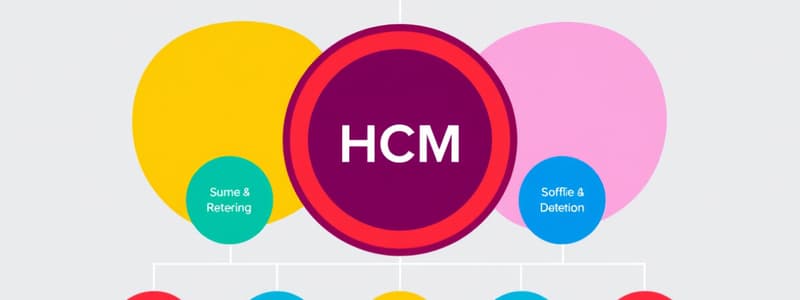Podcast
Questions and Answers
What is the primary purpose of Human Capital Management (HCM)?
What is the primary purpose of Human Capital Management (HCM)?
- To provide technological solutions for payroll management
- To maintain employee satisfaction and engagement solely
- To enforce legal compliance within organizations
- To recruit, manage, and develop an organization’s workforce (correct)
Which component is NOT part of the HCM organizational structure?
Which component is NOT part of the HCM organizational structure?
- Personnel Area
- Workflow Process (correct)
- Enterprise Structure
- Personnel Subarea
What does the 'Client' represent in the HCM Enterprise Structure?
What does the 'Client' represent in the HCM Enterprise Structure?
- A financial reporting unit
- An independent environment in the system (correct)
- The overall company organization
- A department within the company
Why is the organizational structure crucial for SAP HCM?
Why is the organizational structure crucial for SAP HCM?
What is an example of a personnel area in the HCM Enterprise Structure?
What is an example of a personnel area in the HCM Enterprise Structure?
Which of the following is a function of the SAP HCM software?
Which of the following is a function of the SAP HCM software?
What aspect does the Personnel Subarea differentiate within a personnel area?
What aspect does the Personnel Subarea differentiate within a personnel area?
How has employee expectations influenced HCM practices?
How has employee expectations influenced HCM practices?
What is the purpose of a Personnel Group in the personnel structure?
What is the purpose of a Personnel Group in the personnel structure?
Which of the following best describes an Employee Subgroup?
Which of the following best describes an Employee Subgroup?
How is a Position defined within the organizational plan?
How is a Position defined within the organizational plan?
What characterizes an Organization Unit in the context of personnel structure?
What characterizes an Organization Unit in the context of personnel structure?
Which of the following statements about a Cost Center is correct?
Which of the following statements about a Cost Center is correct?
What is the function of the Personnel Number in SAP HCM?
What is the function of the Personnel Number in SAP HCM?
What is indicated by the Reference Personnel Number?
What is indicated by the Reference Personnel Number?
Which of the following is NOT a component of the Organizational Plan?
Which of the following is NOT a component of the Organizational Plan?
What is the purpose of the old personnel number when recreating an employee in the system?
What is the purpose of the old personnel number when recreating an employee in the system?
Which of the following is NOT a way InfoTypes can be maintained in SAP HCM?
Which of the following is NOT a way InfoTypes can be maintained in SAP HCM?
What do InfoTypes primarily represent in Human Resource Management?
What do InfoTypes primarily represent in Human Resource Management?
Which function is NOT a role of Organizational Management in SAP HCM?
Which function is NOT a role of Organizational Management in SAP HCM?
What is the main objective of the recruitment process?
What is the main objective of the recruitment process?
Which component of SAP HCM is responsible for maintaining personnel master data?
Which component of SAP HCM is responsible for maintaining personnel master data?
How is automatic history created in Personnel Administration?
How is automatic history created in Personnel Administration?
What do sub-types within InfoTypes represent?
What do sub-types within InfoTypes represent?
What is the primary goal of recruitment in SAP HCM?
What is the primary goal of recruitment in SAP HCM?
Which of the following does not describe a type of recruitment?
Which of the following does not describe a type of recruitment?
How does the Global Selection Procedure function in SAP HCM?
How does the Global Selection Procedure function in SAP HCM?
What is the outcome of comparing job requirements with employee qualifications in personnel development?
What is the outcome of comparing job requirements with employee qualifications in personnel development?
In which structure are applicants classified based on their employment relationship type in SAP HCM?
In which structure are applicants classified based on their employment relationship type in SAP HCM?
Which system supports HR in planning and administrating teaching and development actions?
Which system supports HR in planning and administrating teaching and development actions?
What happens if an applicant is not selected in the Global Selection Procedure?
What happens if an applicant is not selected in the Global Selection Procedure?
Which method is used in SAP HCM for maintaining applicant data?
Which method is used in SAP HCM for maintaining applicant data?
What is the purpose of profile matchup in performance management?
What is the purpose of profile matchup in performance management?
Which term describes when employee qualifications exceed the requirements of a position?
Which term describes when employee qualifications exceed the requirements of a position?
Which of the following is NOT a type of result from comparing qualification and requirement characteristics?
Which of the following is NOT a type of result from comparing qualification and requirement characteristics?
Which component is essential for the career planning process?
Which component is essential for the career planning process?
What is the primary function of succession planning within talent management?
What is the primary function of succession planning within talent management?
What is included in a development plan?
What is included in a development plan?
In the context of qualifications, what does the term 'half-life period' refer to?
In the context of qualifications, what does the term 'half-life period' refer to?
Qualification catalogs in customizing typically consist of what structural element?
Qualification catalogs in customizing typically consist of what structural element?
Study Notes
Human Capital Management (HCM)
- HCM encompasses practices for recruiting, managing, and developing an organization's workforce.
- SAP HCM software is integral for optimizing HR tasks and supporting organizational objectives.
- Employee expectations have evolved, emphasizing experiences in recruitment and retention.
HCM Organizational Structure
- Organizational structure illustrates hierarchies and employee responsibilities, critical for workflow understanding.
- Three components of the HCM organizational structure: Enterprise, Personnel, and Organizational Plan.
Enterprise Structure
- Represents formal and financial structures, necessitating every employee's assignment.
- Key units include:
- Client: Independent system environment.
- Company Code: Legal accounting unit.
- Personnel Area: Company area differentiated for administration, time management, and expenses.
- Personnel Subarea: Further division within a personnel area.
Personnel Structure
- Reflects an employee's position, characterized by:
- Employee Group: Categories like active employees, retirees.
- Employee Subgroup: Specific classifications within groups, like industrial or commercial occupations.
Organizational Plan
- Focuses on employee functions with each element represented as an object.
- Includes:
- Organization Unit: Functional/regional grouping.
- Position: Assigned to departments.
- Person: Employees filling positions.
- Cost Center: Financial tracking linked to positions.
- Job: General descriptions of roles.
HCM Master Data
- Consists of essential employee identifiers and data management structures in SAP HCM.
- Personnel Number: Unique identifier with up to eight digits.
- Reference Personnel Number: Maps contractual relationships for concurrent employment.
- InfoTypes: Collections of related data fields structured by business needs, each identified by a four-digit ID.
HCM Processes
- A range of processes unified under SAP HCM, including:
- Organizational Management: Models corporate structure to analyze workforce and plan costs.
- Personnel Administration: Maintains personnel data for reporting and integrity checks.
- Recruitment: Focused on acquiring qualified personnel through internal and external channels.
- Personnel Development: Aims to enhance employee skills and qualifications for future needs.
Recruitment Process
- Comprises stages from job vacancy to hiring, enhancing applicant database management.
- Distinguishes between global recruitment and vacancy-specific processes, maintaining applicant statuses.
Personnel Development and Talent Management
- Personnel Development: Plans training based on qualifications and skill deficits, facilitated by comparison processes like profile matchups.
- Talent Management: Involves career and succession planning, generating development plans for employee growth.
Key Outcomes of the HCM System
- Ensures HR can adapt to evolving workforce demands, fostering better recruitment, administration, and development of talent through structured processes and tools.
Studying That Suits You
Use AI to generate personalized quizzes and flashcards to suit your learning preferences.
Description
This quiz covers the fundamental concepts of Human Capital Management (HCM), including its practices in recruiting, managing, and developing the workforce. It also delves into the organizational structure essential for understanding employee responsibilities and workflow. Test your knowledge of SAP HCM software and the various components that form the HCM structure.




